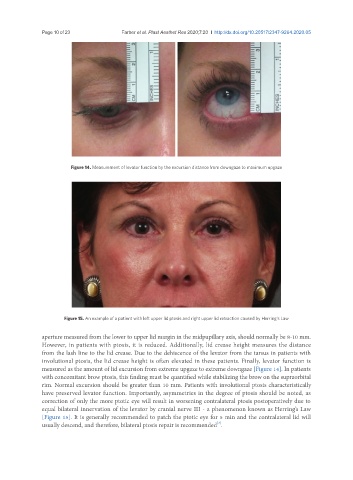Page 209 - Read Online
P. 209
Page 10 of 23 Farber et al. Plast Aesthet Res 2020;7:20 I http://dx.doi.org/10.20517/2347-9264.2020.05
Figure 14. Measurement of levator function by the excursion distance from downgaze to maximum upgaze
Figure 15. An example of a patient with left upper lid ptosis and right upper lid retraction caused by Herring’s Law
aperture measured from the lower to upper lid margin in the midpupillary axis, should normally be 8-10 mm.
However, in patients with ptosis, it is reduced. Additionally, lid crease height measures the distance
from the lash line to the lid crease. Due to the dehiscence of the levator from the tarsus in patients with
involutional ptosis, the lid crease height is often elevated in these patients. Finally, levator function is
measured as the amount of lid excursion from extreme upgaze to extreme downgaze [Figure 14]. In patients
with concomitant brow ptosis, this finding must be quantified while stabilizing the brow on the supraorbital
rim. Normal excursion should be greater than 10 mm. Patients with involutional ptosis characteristically
have preserved levator function. Importantly, asymmetries in the degree of ptosis should be noted, as
correction of only the more ptotic eye will result in worsening contralateral ptosis postoperatively due to
equal bilateral innervation of the levator by cranial nerve III - a phenomenon known as Herring’s Law
[Figure 15]. It is generally recommended to patch the ptotic eye for 5 min and the contralateral lid will
[3]
usually descend, and therefore, bilateral ptosis repair is recommended .

